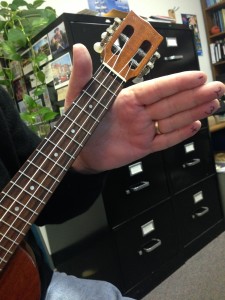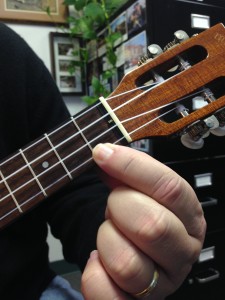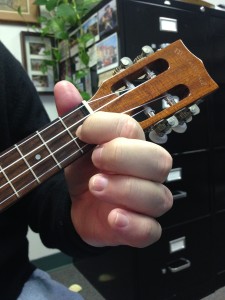

Dr. Rick Maxson loves to share his love of ukulele with his students.
And the associate professor of communication at Drury University recently sat down to share that love with The Scoop.
“If this is the first time you’ve ever played a ukulele, you will want to know how to hold it,” says Maxson, who usually plays with Drury’s ukulele club, DUkes at 5 p.m. every Tuesday at Big Momma’s coffee shop on Commercial Street.
“You will want to know how to tune it. You will want to know what to do with your left and what to do with your right hand.”
How to hold it (assuming you’re right-handed)
- Step 1: Take the ukulele out of the case.
- Step 2: Lay the long, thin part (called a neck) in that space between your thumb and forefinger.
- Step 3: Rest the ukulele on your knee while sitting down. Maxson says this position is the secure way of holding the instrument.
How to tune it
- Step 1: Learn the notes that the strings correspond to
“Tuning the ukulele is as easy as G, C, E, A,” Maxson says. He jokes that a person needs to tune because “you don’t want to be too annoying when you play this.”
- Step 2: Turn the tuning keys to match the pitch
“It is just a matter of turning that little key to the left or the right until the pitch of that string matches a G; the second one, C; the third one, E; and the last one, A. That is how a ukulele is tuned.”
How to play

- Step 1: Learn how your fingers are numbered.
“The pointer finger is going to be ‘one.’ That next finger that makes the peace sign is going to be ‘two.’ Your ring finger is number three and our pinky will be number four,” Maxson explains.
- Step 2: Learn how the strings are numbered.
“There are four strings,” says Maxson, “Those four strings run over probably 15 fret spaces, and you are probably using four fingers.”
He compared the strings to the floors of a multistory building. “The string closest to the floor is number one, hence first floor. The string closest to the ceiling is number four, hence fourth floor.”
- Step 3: Learn about the spaces.
“The spaces are divided by fret wires,” he says. “The first one is the first space. As you go up the neck, going closer to the body of the ukulele, the pitch goes up as I move up those spaces.”
- Step 4: Learn what to do with your right and left hand
What should you do with your right and left hands? “Play the ukulele,” Maxson jokes.
Seriously: “Your left hand is in charge of pushing down certain strings at certain intervals to make chords. The right hand comes in when you are about to strum the ukulele. I’m going to use my thumb and strum from the fourth string to the first string — from the ceiling to the floor.”
Finally…
How to play a song
- Step 1: Learn a C7 chord
“I’m going to take my pointer finger, and I’m going to place it on the first space, on the first string — one, one, and one. I’m going to press that string down,” says Maxson. “First finger, first space, first string makes the C7 chord.”

Now, you can play your first song.
“If this was a lesson, I’d ask you to keep strumming and sing, ‘Put the lime in the coconut and drink it all up’,” pulling a line from Harry Nilsson’s “Coconut.” Maxson proceeds to strum and sing the line to demonstrate. “You would make a full song out of one chord.”
- Step 2: Learn an F chord
“First finger, first space, second string,” says Maxson. “Now, you are well on your way to learning hundreds of songs on a ukulele.”

Watch the video below to listen to a song that can be played using these two chords.